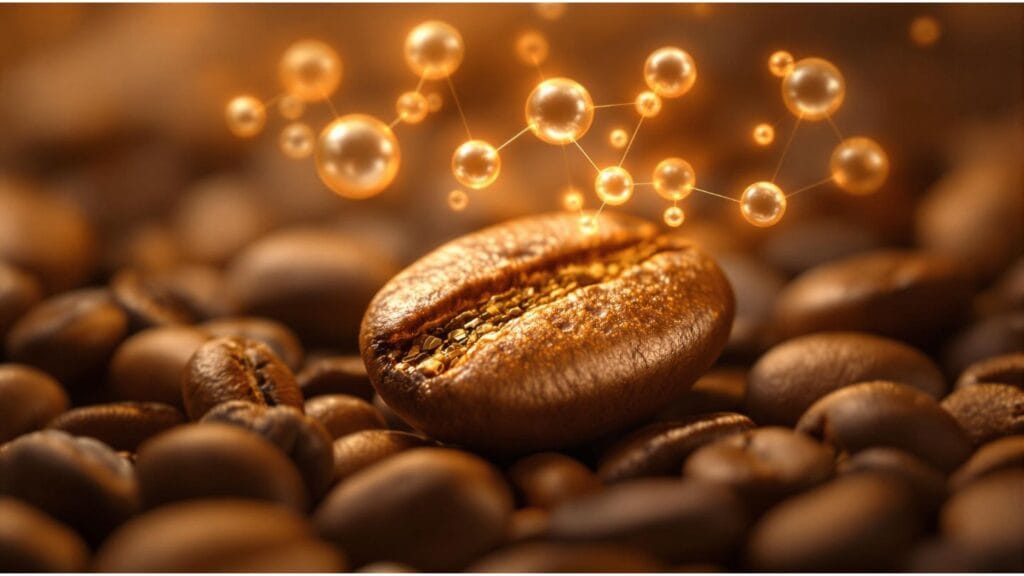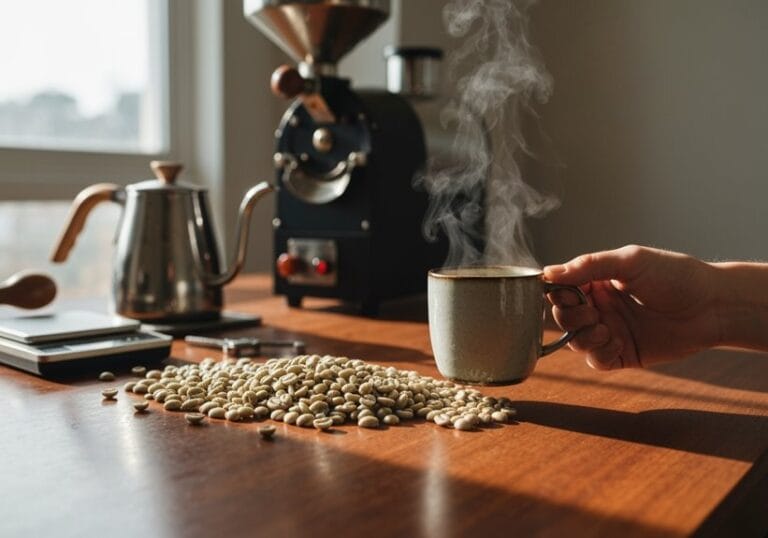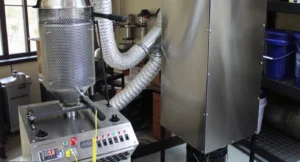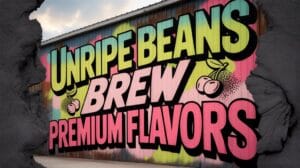Roasting specialty coffee for quality is like riding a rollercoaster—you’ve got to balance the highs and lows! Start by picking the roast level that suits your flavor craving, whether it’s that bright floral taste or bold chocolatey goodness. Use a good roaster, like a drum for deep flavors or a fluid bed for a zesty kick. And remember, precision is key! Nail those temperatures and timing, or you might end up with coffee that tastes like burnt toast (oops!). Stick around, and you’ll uncover the secret to mastering the roast!
Key Takeaways
- Select the appropriate roast degree to enhance origin characteristics, balancing acidity and sweetness for desired flavor profiles.
- Utilize a reliable roasting technology, like drum or electric roasters, for consistent and high-quality results.
- Monitor temperature and timing closely to control chemical changes, ensuring balanced sweetness without over-roasting.
- Implement quality control measures, including regular cupping and colorimeters, to maintain flavor integrity across batches.
- Embrace the artistry of roasting by understanding the complex interplay of variables that affect the final cup’s flavor.
Understanding Roast Degree and Its Impact on Flavor
Regarding roasting coffee, you might be surprised to learn that the roast degree can make a world of difference in what ends up in your cup—yes, seriously!
Imagine this: you start with the same beans, but depending on how long and hot you roast them, you could go from delicate floral notes to robust chocolatey flavors. It’s like magic, but, ya know, science! As a result of roasting approach, lighter roasts can preserve the essential characteristics of the beans’ origin, allowing you to appreciate their unique terroir. In fact, blonde roast coffee has been shown to retain more caffeine compared to darker roasts, contributing to its flavor profile.
Roasting coffee is like a flavor wizardry—same beans, but the heat transforms delicate florals into rich, chocolatey bliss!
As for roast profiling, light roasts keep those fruity nuances, while dark roasts? They’re more like your bitter friend who’s always got a smoky story. The Agtron scale helps quantify these differences, with roast levels ranging from very light to very dark, ultimately affecting the taste.
Flavors develop differently through the roast levels, turning a coffee experience into a delightful rollercoaster—just don’t pony up for overly dark ones unless you want to feel like you’re sipping on charcoal!
Choosing the Right Roasting Technology
Choosing the right roasting technology can feel like choosing the perfect coffee mug—everyone has their favorite, but not all are likewise effective! When debating between Drum vs. Fluid, consider that drum roasters provide deeper flavors but demand skilled management, while fluid bed roasters whip up a quicker roast with bright acidity. Additionally, the roasting process should reflect specialty coffee characteristics to ensure a premium experience. And let’s not forget electric roasters—far from your grandma’s toaster! They boast tight temperature control, making every bean feel like royalty. Additionally, understanding the moisture content of your green coffee beans is essential for optimal roast development.
Here’s a handy comparison:
| Roaster Type | Key Benefits |
|---|---|
| Drum Roasters | Deep, complex flavors |
| Fluid Bed Roasters | Bright acidity and quick roasting |
| Electric Roasters | Precise control and consistency |
| Manual Pan Roasting | Unique caramelized flavors |
Choosing wisely means your caffeine fix will never taste like burnt toast!
The Importance of Chemical Changes During Roasting

Roasting coffee isn’t just throwing some beans into heat and hoping for the best—oh no, it’s a full-on chemical symphony!
During roasting, chemical transformations take center stage, setting the stage for flavor development.
- The Maillard reaction kicks off at around 150°C, creating sweet melanoidins that make coffee rich and complex.
- Caramelization happens later, around 160°C, adding to those delightful caramel notes.
- But beware! Overdoing it leads to burnt flavors that no one wants in their cup!
Controlling these reactions is essential, as they shape everything from sweetness to bitterness.
It’s like being the conductor of flavor—one wrong note, and you’ve got a cup that sings sour notes instead of sweet symphonies!
Implementing Quality Control and Consistency in Roasting
While it might seem tempting to just wing it when roasting coffee, that approach can lead to some seriously questionable results—think burnt beans or flavor disasters that even a caffeine addict wouldn’t dare sip!
Implementing a solid quality control framework can save a roaster’s sanity. To begin with, clear quality standards are essential. Using precise roasting techniques, like tracking development time and end temperature, is key.
Fancy gadgets, like colorimeters, help catch those pesky inconsistencies. Regular cupping with trained pros guarantees the coffee doesn’t taste like muddy water.
And, let’s be honest, no one wants to be the “roast of the month” disaster! By integrating checkpoints and sampling every batch, a roaster can keep those flavors on point and avoid cat-astrophes in the cup!
Frequently Asked Questions
What Are the Best Coffee Bean Varieties for Roasting?
The best coffee bean varieties for roasting include prominent Arabica varieties such as Typica and Gesha, known for their complex flavors, alongside Robusta characteristics that contribute body and caffeine, especially in espresso blends.
How Does Humidity Affect Roasting Outcomes?
Humidity levels considerably impact roasting outcomes by affecting moisture content in beans. Higher ambient humidity accelerates roasting, while excessive moisture may lead to uneven results, compromising flavor development and quality. Precision in moisture management is essential.
Can You Reuse Coffee Grounds After Roasting?
Used coffee grounds can be reused, particularly for flavor extraction in different applications such as composting and natural pest control. Their nitrogen content and beneficial properties support sustainable gardening practices and improve soil health.
What’s the Ideal Storage Method for Roasted Beans?
The ideal storage method for roasted beans involves using airtight containers to block oxygen and maintaining temperature control between 15-24°C. This guarantees prolonged freshness, flavor retention, and protection from environmental factors like light and humidity.
How Do Environmental Factors Influence Roast Profiles?
Environmental factors, including temperature control and altitude impact, considerably alter roast profiles. Lower temperatures slow roasting, while high altitudes necessitate higher heat application, ultimately affecting flavor development and consistency throughout the roasting process.





